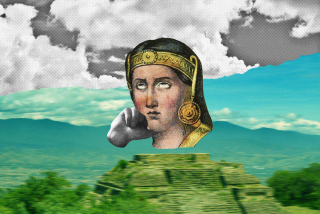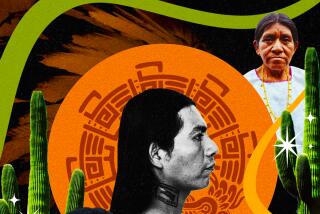After Columbus : Indians Try to Revive Cultures Despite Pressures to Assimilate
- Share via
MEXICO CITY — Five hundred years ago, Christopher Columbus came upon a world with hundreds of languages, thousands of cultures and at least 40 million people.
He and those who followed him brought European diseases, war and oppression that killed 80% to 90% of those people. Religions, cultures, entire nations vanished.
Only now, some experts say, are there once again as many Indians in the hemisphere as there were when Columbus “discovered” them.
Indian activists throughout the Americas say a revival of their cultures is taking place despite pressures on them to modernize and assimilate.
“There is a general revitalization,” said Jacinto Arias, a Mayan who studied anthropology at Princeton and works on Indian cultural affairs for the Mexican state of Chiapas.
“In past centuries . . . the Indian defended himself, but with a shell, like a tortoise,” Arias said. “He hid in the mountains. We have to change that. We have to show our faces.”
Canada has created an Indian territory over a vast part of its northern land and is negotiating constitutional changes to grant its aborigines greater rights.
In 1991, Brazil created a 37,000-square-mile Indian reserve in the Amazon. Ecuador has turned over 2.8 million acres of rain forest to 20,000 Indians.
Mexico, Colombia, Bolivia and Argentina have written laws or changed their constitutions to guarantee native rights.
U.S. tribes are trying to revive traditions and languages nearly lost. In recent years, they have reclaimed large territories and used water rights for economic development or political leverage with thirsty Western states.
The United Nations is sponsoring a Year of Indian People in 1993. Activists hope it will help their cause.
Native American nations could even emerge in South America, said Jose Matos, director of the Interamerican Indian Institute, a 17-nation group affiliated with the Organization of American States.
“In Peru, for example . . . a population of 8 million or 10 million Quechuas or Aymaras could very well unite as an ethnic group and reclaim nationhood,” said Matos, himself a Quechua.
“If they continue to be discriminated against, marginalized, disregarded, put down, mistreated, then logically they are going to reject” the existing state, he said.
Such a course appears far-fetched to many Indians in the United States and Canada, who have a measure of self-rule unusual in Latin America.
“That doesn’t seem like a practical reality without taking up arms, and I doubt that would ever happen,” said Rose Robinson, program officer with the National Congress of American Indians in Washington.
She said most Indians “are very patriotic. . . . Our veterans are very proud of being veterans.”
The last large-scale Indian rebellion may have been Mexico’s War of the Castes. Mayan Indians in the Yucatan Peninsula rallied behind the symbol of “the talking cross” in 1847 and defied central control until the turn of the century.
More than 1,000 Indian cultures survive in the Americas. They range in size from a few bands of a few dozen people in California to such entire nations as the Quechua of Peru.
Guatemala and Bolivia have Indian majorities and non-Indian ruling elites. Mexico and Peru have the largest Indian populations, with 8 million to 10 million each.
The United States has 2 million Indians in 500 government-recognized cultures speaking 250 distinct languages, according to the Bureau of Indian Affairs.
Tens of thousands of other Indians seek to regain federal recognition they lost when the government “terminated” their tribes in an effort to pull them into the mainstream culture.
“Our first policy as a nation was to kill the Indians, kill them all,” said Rep. Eni F.H. Faleomavaega, a Democrat from Samoa who presided at a House Interior Committee hearing on termination in July.
“That was followed by the policy of assimilation,” he said. “After assimilation, the policy was, ‘Let’s terminate them as tribes.’ That didn’t work, so we’re now in the process of restoring dignity to the Native American community.”
The Bush Administration contends that the government has the power to terminate the rights of any tribe, even one recognized by treaty.
One of the largest Indian populations in the United States--hundreds of thousands of Mexican Indians who work there--is not included in federal figures.
Matos said his organization estimates the total native population of the Americas at about 40 million, roughly what it was in 1492. Others put it as high as 60 million.
Latin American countries tend to define Indians by language. The United States and Canada use tribal membership or self-description.
While the overall Indian population is growing, some tribes suffer the same epidemics that struck their ancestors when they encountered European diseases.
Prospectors who have swarmed into the remote Brazilian rain forest since 1987 carry diseases that have killed an estimated 2,000 of the 22,000 Yanomami Indians in the area. Thousands more Yanomami have malaria.
Native peoples throughout the United States have been forced into remote areas, stripped of their resources and exploited. In rural Mexico, officials say, conflicts over land in Indian areas remain the major source of violence.
Because industrial development has not reached them, many Indians have turned to alternative incomes.
In the United States, Indians have embraced gambling casinos. Those in Mexico, Bolivia and some other countries have created tourist handicraft businesses.
“The Indian population occupies the most critically poor sector of the Americas,” Matos said. “They suffer from political, economic, social, cultural and even racial discrimination.”
Columbus, who thought he had reached the East Indies, used the term “Indian” to cover a range of cultures at least as diverse as those of Europe.
There were quasi-democratic federations such as the Iroquois and blood-drenched imperialists such as the Aztecs.
Some knew little of agriculture and were illiterate. Others built cities as large as any in the world, engineered vast water systems, studied mathematics and wrote poetry.
More to Read
Sign up for Essential California
The most important California stories and recommendations in your inbox every morning.
You may occasionally receive promotional content from the Los Angeles Times.













